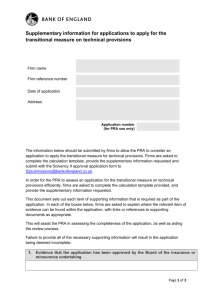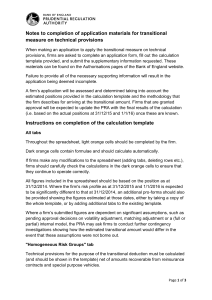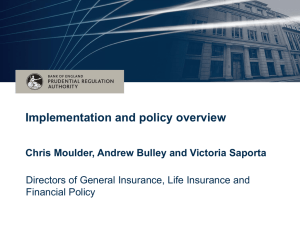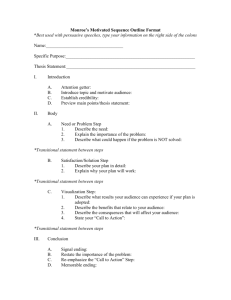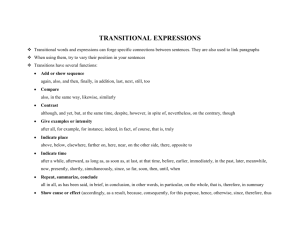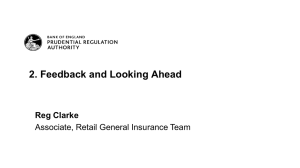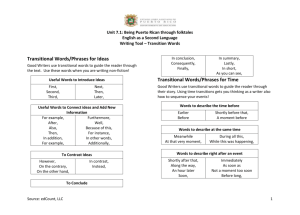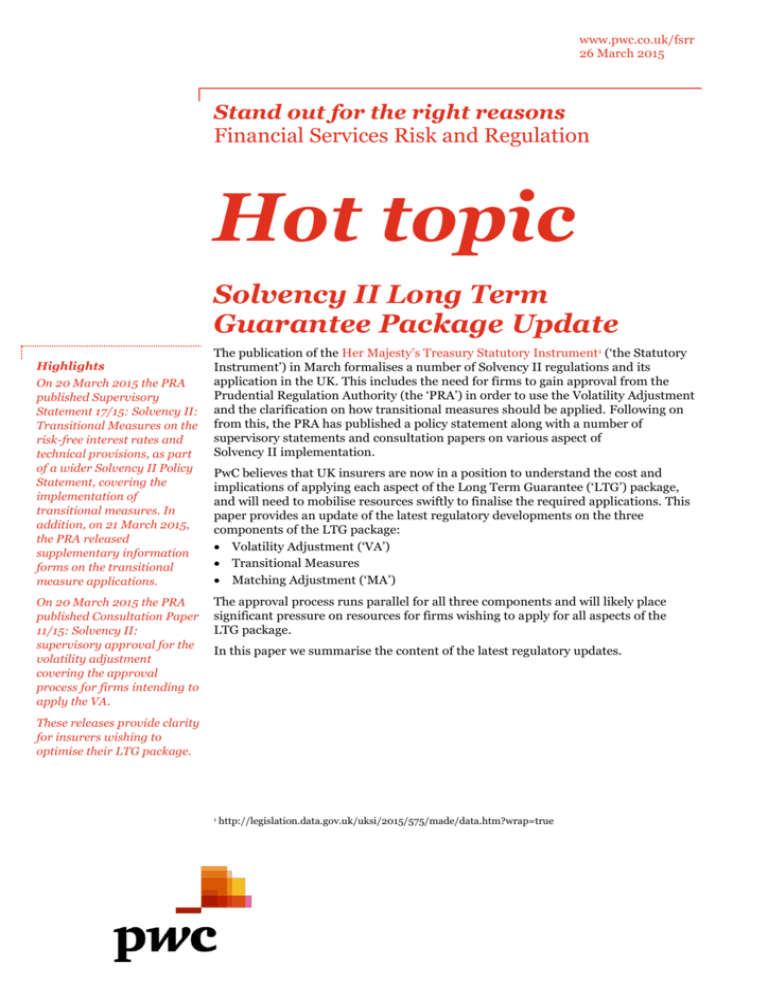
www.pwc.co.uk/fsrr
26 March 2015
Stand out for the right reasons
Financial Services Risk and Regulation
Hot topic
Solvency II Long Term
Guarantee Package Update
Highlights
On 20 March 2015 the PRA
published Supervisory
Statement 17/15: Solvency II:
Transitional Measures on the
risk-free interest rates and
technical provisions, as part
of a wider Solvency II Policy
Statement, covering the
implementation of
transitional measures. In
addition, on 21 March 2015,
the PRA released
supplementary information
forms on the transitional
measure applications.
On 20 March 2015 the PRA
published Consultation Paper
11/15: Solvency II:
supervisory approval for the
volatility adjustment
covering the approval
process for firms intending to
apply the VA.
The publication of the Her Majesty’s Treasury Statutory Instrument1 (‘the Statutory
Instrument’) in March formalises a number of Solvency II regulations and its
application in the UK. This includes the need for firms to gain approval from the
Prudential Regulation Authority (the ‘PRA’) in order to use the Volatility Adjustment
and the clarification on how transitional measures should be applied. Following on
from this, the PRA has published a policy statement along with a number of
supervisory statements and consultation papers on various aspect of
Solvency II implementation.
PwC believes that UK insurers are now in a position to understand the cost and
implications of applying each aspect of the Long Term Guarantee (‘LTG’) package,
and will need to mobilise resources swiftly to finalise the required applications. This
paper provides an update of the latest regulatory developments on the three
components of the LTG package:
Volatility Adjustment (‘VA’)
Transitional Measures
Matching Adjustment (‘MA’)
The approval process runs parallel for all three components and will likely place
significant pressure on resources for firms wishing to apply for all aspects of the
LTG package.
In this paper we summarise the content of the latest regulatory updates.
These releases provide clarity
for insurers wishing to
optimise their LTG package.
1
http://legislation.data.gov.uk/uksi/2015/575/made/data.htm?wrap=true
Volatility adjustment
On 20 March 2015 the PRA published Consultation
Paper 11/15: Solvency II: supervisory approval for the
volatility adjustment2 (‘the Consultation’) covering the
approval process for firms intending to apply the VA.
The VA provides an uplift in the discount rate used to
calculate best estimate liabilities and may be of
particular interest for insurers for whom the MA is
not appropriate. The Consultation is open for
comments until 20 April 2015.
Summary
Firms wishing to apply the VA to their portfolio will
have to seek approval from the PRA. The approval
process opens on 1 April 2015, before the end of the
consultation period.
The Statutory Instrument sets out three statutory
conditions that firms need to demonstrate compliance
with in order to gain approval from the PRA to
use VA.
Firms intending to proceed with the application
process will need to ensure that there are processes
and governance in place to comply with the statutory
conditions, as well as detailed quantitative analysis on
the balance sheet impact of using VA.
Approval process for the VA
Firms should notify the PRA at the earliest
opportunity should they wish to apply for the VA. All
insurers will be able to send to the PRA a formal
application from 1 April 2015. This overlaps with the
consultation period which may indicate that the PRA
is not expecting material changes to the proposal set
out in the Consultation. It is unclear how long the
PRA will have to confirm the application is complete
although we note that the standard period is 30 days.
For the majority of insurers, the PRA will have 6
months from the date of receipt of the complete
application to assess it and communicate the results
of the assessment to the insurer.
For insurers whose VA application is independent of
other approval decisions, such as internal model
applications, the PRA will endeavour to communicate
decisions within 6 weeks.
For insurers intending to use the VA as a contingency
option should another application be rejected, the
PRA is willing to consider these applications in
parallel. Whilst this will help provide certainty to
firms whose applications are interdependent, the
timescale available for those firms considering an
early application may need to be evaluated given the
short time available to develop their VA application.
http://www.bankofengland.co.uk/pra/Pages/publications/
cp/2015/cp1115.aspx
2
2 Hot Topic Financial Services Risk and Regulation
When submitting this application insurers should
inform the PRA of any other approvals for which they
have applied and are also encouraged to include
details of other approvals they intend to apply for
within the next year.
The Consultation does not mention the need for
sensitivity tests to be carried out showing the impact
on the VA if other applications are rejected. This may
indicate a belief from the PRA that this information
will be available in other applications.
Content of the VA application
The application should allow the PRA to be satisfied
that the regulation as set out in the Statutory
Instrument has been met, namely:
1. The VA is correctly applied to the relevant risk-free
interest rate term structure in order to calculate
the best estimate liabilities;
2. The application of the VA does not create an
incentive for firms to engage in pro-cyclical
investment behaviour; and
3. The firm does not breach a regulatory requirement
as a result or consequence of applying the VA.
The Consultation specifies that the VA application
should include the following:
1. The written policy on risk management including
the criteria for application of the VA as well as the
required assessment of sensitivity;
2. The liquidity plan in relation to the assets and
liabilities subject to the VA;
3. An assessment of the impact when VA is reduced
to zero. Where this results in non-compliance with
the Solvency Capital Requirement, an analysis of
the measures that could be used to restore
compliance; and
4. An assessment, as part of the Own Risk and
Solvency Assessment, of compliance with capital
requirements with and without taking into account
the VA.
Key considerations for the VA
application
Firms will need to adapt their current risk
management framework, process and governance to
include ongoing compliance with the criteria as set
out in the application. This will include ensuring that
the criteria are aligned with how the portfolio is
managed and do not cause excessive disruption to
business. The implementation of these is likely to
incur additional initial and ongoing costs.
Whilst the Consultation does not specify the type of
liabilities eligible for VA, the focus is on the liquidity
of the liabilities. The need to demonstrate that
cashflows are sufficiently predictable means that it
may be difficult to gain approval on a range of
liabilities, for example unit linked.
The quantitative assessment needs to demonstrate
that use of the VA is in line with the investment
policy. Management may wish to consider how the VA
may impact on the portfolio investment strategy and
the basis risk between the reference portfolio and the
current portfolio, in particular the need to maintain a
portfolio yield that will ensure the discount rate is
representative. Insurers will also need to consider
carefully actions that will be taken under stress, which
may confine freedom of management to react
appropriately to market conditions.
Transitional measures
On 20 March 2015 the PRA published Supervisory
Statement 17/15: Solvency II: Transitional Measures
on the risk-free interest rates and technical
provisions3 (‘the Statement’), as part of a wider
Solvency II Policy Statement4, covering the
implementation of transitional measures. In addition,
on 21 March 2015, the PRA released supplementary
information forms on the transitional
measure applications5.
The transitional measures give insurers the
opportunity to delay some of the impact of moving
from Solvency I to Solvency II. However there are a
number of implications to consider and it is critical
that firms fully understand how to apply the
transitional measures and how to embed these into
the business plan.
Summary
Firms wishing to apply transitional measures will
need to seek approval from the PRA. Both transitional
measures decrease linearly for up to a maximum of
16 years.
Firms may apply to dynamically recalculate the
Technical Provisions (‘TP’) transitional measure.
The amount of the TP transitional measure is limited
at legal entity level to ensure the Financial Resources
Requirement (‘FRR’) under the transitioned
Solvency II position is greater than or equal to the
FRR under Solvency I.
The TP transitional measure can be applied at
Homogenous Risk Group (‘HRG’) level.
http://www.bankofengland.co.uk/pra/Pages/publications/ss/2015/
ss1715.aspx
4 http://www.bankofengland.co.uk/pra/Pages/publications/ps/2015/
ps215.aspx
5 http://www.bankofengland.co.uk/pra/Pages/authorisations/siiapprovals/
applying.aspx
3
3 Hot Topic Financial Services Risk and Regulation
The risk free rate (‘RFR’) transitional can only be
applied to liabilities which are not included in the
MA calculation.
Technical provisions transitional
A transitional deduction should be calculated as the
difference between the Solvency II TPs and the
Solvency I Pillar 2 (ICA) TPs. This deduction is
limited by the FRR test which reduces the transitional
adjustment to ensure the FRR under the transitioned
Solvency II position is greater than or equal to that
under Solvency I.
The FRR test should be calculated based on all
liabilities at entity level, and firms should explain why
any non-technical reserves have been removed for the
calculation of the technical provisions.
The transitional deduction calculated as at 31
December 2015 is not expected to be assessed again
except in the following cases:
The firm has received approval from the PRA to
recalculate the deduction;
A material change in the firm’s risk profile or
market conditions has occurred; and
At the instruction of the PRA.
For firms applying the TP transitional measure at
homogenous risk group level, this can be no more
granular than the HRG used to segment the TPs
under Solvency II.
Risk-free interest rate transitional
The transitional adjustment for the risk-free rate
(‘RFR’) transitional is calculated as at 31 December
2015 and is the difference between the Pillar 1 interest
rate (calculated in line with INSPRU 3.1) and the
single discount rate that, when applied, will result in a
value equal to the best estimate of the portfolio using
the Solvency II risk-free rate, adjusted for the VA
(where firms have been granted approval).
Implications for insurers seeking to
apply the transitional measures
Approval process
Firms should notify the PRA at the earliest
opportunity should they wish to apply for the
transitional measures. Formal application opens on
1 April 2015. The PRA will have 30 days to confirm
the application is complete. Applications will take
6 months for the PRA to review.
Insurer should inform the PRA of any other
approvals in progress, or planned for the coming
12 months, with a sensitivity of the impact of the
transitional measures if other applications
are rejected.
The PRA has provided more guidance on the
application for the TP transitional compared to
the RFR transitional. Hence firms may wish to
infer the information the PRA may require for the
RFR transitional application based upon the TP
transitional guidance.
The PRA may request firms to obtain external
validation of the calculations performed.
The guidance for the content of the TP
transitional measure application includes a
calculation template, notes on the application and
supplementary information requested. The focus
is on the explanation and justification of
the calculations.
The application should be made based on figures
as at 31 December 2014, with an explanation for
why these figures are appropriate. If the risk
profile of the firm is likely to materially change
during 2015, firms are asked to estimate the
figures for the calculation at 31 December 2015.
Recalculation
Firms using the TP transitional need to decide
whether to apply to recalculate the transitional.
Should the transitional adjustment remain static,
firms will be exposed to relative movements between
the credit spreads over time which could create
significant balance sheet volatility.
In any case, the requirement to re-assess the level of
TP deduction under a material change in risk profile,
or at the insistence of the PRA could introduce a
considerable practical burden for firms; it will likely
require that the Pillar 1 and ICA models and
assumptions are kept up-to-date and re-run each year
for the assessment.
Deciding on the right group of liabilities
Applying the TP transitional at HRG level introduces
additional complexity for calculations. Firms must
demonstrate the calculations at HRG level are
consistent with calculations for the entity as a whole.
Firms must consider how to limit each HRG to allow
for the FRR limit being applied at legal entity rather
than HRG level, taking into account the contribution
to the TP transitional measure from that HRG and the
effect on the level of policyholder protection.
Validation of the calculations
There may not be time for the year end 2015 technical
provisions to be validated prior to using them to
calculate the transitional and applying it to the
Solvency II balance sheet in Q1 2016. Firms need to
factor this into their plans for external validation.
The PRA also appears to have opened the door for
firms to discuss the appropriateness of any existing ICA
margins/ICG where these are felt to no longer be
appropriate. Firms should discuss this with their usual
supervisory contact before completing their application
and factor this into the critical path.
Impact on the business plan
There are wider implications of using transitional
measures on the asset hedging and new
business strategies.
The relative benefits between different firms of using the
transitional measures will be a function of the internal
structures and HRG liabilities held at legal entity level.
Matching adjustment
The following recent regulatory updates have continued
to inform firms preparing their MA final application:
Letter on Equity Release Mortgage6 published by the
PRA on 20 February 2015;
Risk Free Rate technical documentation7 published
by EIOPA on 23 February 2015; and
Letter on Matching Adjustment published8 by the
PRA on 9 March 2015.
We note however that there continues to be high level of
uncertainty within the papers published as well as on the
criteria for MA approval.
Firms who have submitted a pre-application document
will receive feedback from the PRA on 28 March 2015,
with the approval process commencing on
1 April 2015.
http://www.bankofengland.co.uk/pra/Documents/solvency2/
fisherermletterfeb15.pdf
7 https://eiopa.europa.eu/regulation-supervision/insurance/
solvency-ii-technical-information/risk-free-interest-rate-term-structures
8 http://www.bankofengland.co.uk/pra/Documents/solvency2/
intmodmaupdatemar2015.pdf
6
4 Hot Topic Financial Services Risk and Regulation
How PwC can help you understand the implications for your business
Our team has a significant amount of expertise working with insurers on the various components of the LTG
package. We can work with you on:
Understanding the impact on your balance sheet of the various components, such as investment strategy
and capital;
Develop application documents for regulatory approval; and
Update the systems that will need to be in place to implement the measures.
Contacts
Shazia Azim
James Tuley
Scott McNeill
Nicola Kenyon
T: +44 (0)20 7213 2096
E: shazia.azim@uk.pwc.com
T: +44 (0)20 7804 7343
E: james.tuley@uk.pwc.com
T: +44 (0)131 260 4341
E: scott.mcneill@uk.pwc.com
T: +44 (0)20 7804 4931
E: nicola.kenyon@uk.pwc.com
This publication has been prepared for general guidance on matters of interest only, and does not constitute professional advice. You should not act upon the
information contained in this publication without obtaining specific professional advice. No representation or warranty (express or implied) is given as to the
accuracy or completeness of the information contained in this publication, and, to the extent permitted by law, PricewaterhouseCoopers LLP, its members,
employees and agents do not accept or assume any liability, responsibility or duty of care for any consequences of you or anyone else acting, or refraining to
act, in reliance on the information contained in this publication or for any decision based on it.
© 2015 PricewaterhouseCoopers LLP. All rights reserved. In this document, “PwC” refers to PricewaterhouseCoopers LLP (a limited liability partnership in the
United Kingdom), which is a member firm of PricewaterhouseCoopers International Limited, each member firm of which is a separate legal entity.
150326-115302-NK-OS
Stand out for the right reasons
Financial services risk and
regulation is an opportunity.
At PwC we work with you to embrace
change in a way that delivers value to your
customers, and long-term growth and
profits for your business. With our help,
you won’t just avoid potential problems,
you’ll also get ahead.
We support you in four key areas.
By alerting you to financial and
regulatory risks we help you to
understand the position you’re in and
how to comply with regulations. You
can then turn risk and regulation to
your advantage.
We help you to prepare for issues such
as technical difficulties, operational
failure or cyber attacks. By working
with you to develop the systems and
processes that protect your business
you can become more resilient, reliable
and effective.
Adapting your business to achieve
cultural change is right for your
customers and your people. By
equipping you with the insights and
tools you need, we will help transform
your business and turn uncertainty
into opportunity.
Even the best processes or products
sometimes fail. We help repair any
damage swiftly to build even greater
levels of trust and confidence.
Working with PwC brings a clearer
understanding of where you are and
where you want to be. Together, we can
develop transparent and compelling
business strategies for customers,
regulators, employees and stakeholders.
By adding our skills, experience and
expertise to yours, your business can
stand out for the right reasons.
For more information on how we can help
you to stand out visit www.pwc.co.uk

